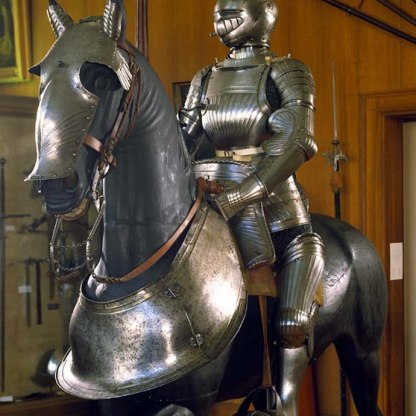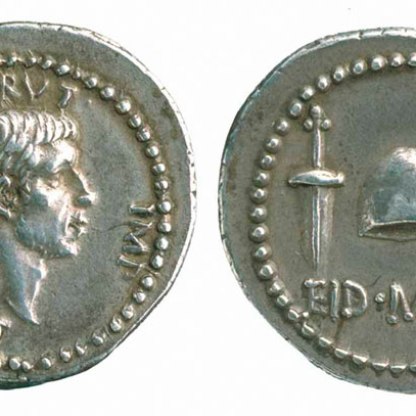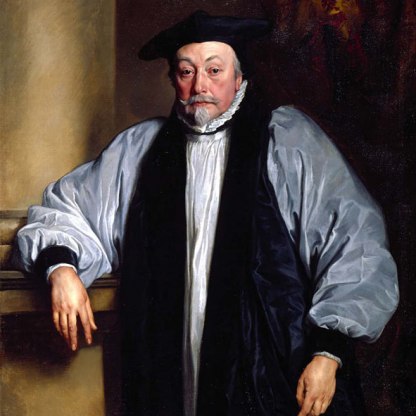Decanter

There's a babyish party named Burges, / Who from infancy hardly emerges: / If you had not been told / He's disgracefully old, / You'd offer a bull's-eye to Burges.
Dante Gabriel Rossetti
This flamboyant and strange-looking object comes from the imagination of a flamboyant and strange-looking individual. A parrot-keeping, rat-hunting, opium-eating Freemason, Burges was an archaeologist and architect who was so short-sighted, it is said, that he once mistook a peacock for a man. He was a great traveller, fascinated in particular by the art and culture of thirteenth-century Europe, and he became a leading figure in the nineteenth-century Gothic revival which dominated English taste between c. 1830 and 1880.
Though William Burges – 'Billy' or 'ugly Burges' to his many friends – is comparatively little known today, affectionate accounts of him by his contemporaries abound, and monuments to his peculiar Victorian Gothic genius still stand: Cardiff Castle and Castell Coch in Wales, and St Finbarre's cathedral in Cork, Ireland.
Of his surviving buildings, one of the most intriguing is the Tower House in Melbury Road, West London, a home that he began designing for himself in 1875. As it neared completion in 1878, Burges started to move his furniture and effects in. The interior became a dazzling testament to his antiquarian enthusiasms, his broad learning and his eccentric imagination. Cultures and colours are mixed to startling, often humourous effect. The porch floor is dominated by a Roman-style mosaic of his favourite dog Pinkie. Above the fireplace in his library, a sculptural frieze shows Queen Grammar issuing orders to the allegorical figures of Pronoun, Verb, Article, Noun, Adjective, Adverb, Conjunction and Preposition. In the guest bedroom, all is gold and crystal, and four emu eggs hang from the butterfly-festooned ceiling. On the beams are represented scenes of the mock-epic battle between the frogs and the mice.
This wine decanter would have blended in perfectly in such florid surroundings. An inscription around the neck tells us that Burges had it made for himself in 1865, and that it was paid for from the proceeds of his prize-winning design for the Crimean Church in Constantinople, a design that was eventually considered too costly to build. Maker's marks reveal that the decanter was constructed for the designer by Josiah Mendelson and George Angell. These two were effectively employed to put together an elaborate three-dimensional jigsaw, for the dark green glass body of the vessel is adorned with a remarkable array of objects from different cultures and periods. It is in many ways typical of the eclecticism of Victorian taste.
The ivory, leonine head of the griffin that makes up the handle, is based upon the pommel of an eighth-century Assyrian dagger in Burges' own collection.
An eighteenth-century Chinese rock crystal lion rests on top of the decanter's lid.
The green glass body and malachite neck are clad in silver, which is itself studded with Greek, Roman and Byzantine coins, Roman and ancient Persian intaglios (carved gems) and coral cameos.
The spout is made of silver and takes the form of a ram's head, the horns curling back to the neck of the vessel.
Silver foliage and animals are applied to the silver casing. On the foot of the decanter, like the fauna found in the margins of a medieval manuscript, we find engraved a hedgehog, a mouse and a wren with a worm in its mouth, accompanied by the inscription I WREN, for Jenny Wren.
Two more decanters closely resembling this one were made to designs by Burges, one of which is now in the Cecil Higgins Art Gallery in Bedford, the other in the Victorian and Albert Museum. An article written in The Builder, six years after Burges' death, described these works as 'the best pieces of modern grotesque to be seen'.
Themes and periods
Data from our collections database
Green glass, mounted in silver set with malachite, semi-precious stone, cloisonné enamels, coral cameos, intaglios, classical coins, ivory and rock crystal
Dark green blown glass body, mounted in silver with applied and engraved ornament, set with malachite panels, semi-precious stone, cloisonné enamels, two 17th century coral cameos each of a nymph's head, one of Cupid holding a basket, and another of Cupid holding a garland, a Roman first century AD nicolo intaglio of a sleeping hound, a Sassanian 5th or 6th century cornelian intaglio of a personal device and six silver-mounted ancient coins; on the neck, a Thracian silver drachm, struck at Byzantion (c. 340-320 BC) and a Roman silver siliqua of Julian II (361-363), possibly struck at the mint in Arles, France; on the body, a Byzantine gold lightweight solidus of Justinian (527-565)m a Byzantine electrum histamenon nomisma of Nicephorus III (1078-81), a Roman silver argentus of Constntine I (307-337) issued during his time as Caesar, dating from 305-307 and struck at the mint in Trier, Germany, and a Byzantine gold histamenon nomisma of Basil II (976-1025). The hinged cover with a Chinese rock crystal Buddhist lion surrounded by leafy foliage (two pieces missing) and a silver palisade, surmounted by a hoop with silver bell, the underside of the cover with an agate, surrounded by silver foliage. The cast silver handle is in the form of a winged lion with a carved elephant-ivory head, and the spout is cast in the form of an antelope's head with emerald eye, with a silver stopper attached by a chain. The foot is engraved with a hedgehog, a frog, a mouse, and a wren with a worm in its beak, and the 'signature' 'I WREN' for Jenny Wren. The partly obscured inscription on the neck reads: WILLIELMUS BURGES ME FIERI FECIT ANNO DI MDCCCLXV EX HONS ECCL[ESI]AE CONSTANTINOPOLITANAE
William Burges (1827-1881). Charles Handley-Read (1916-1972)and Lavinia Handley-Read (d. 1972); purchased from Thomas Stainton, Executor of the Handley-Read Estate
Legal notes
Purchased with the Perceval Fund and with the Regional Fund administered by the Victoria & Albert Museum
Acquisition and important dates
- Method of acquisition: Bought
- Dates: 1972-10-19
Dating
William Burges was one of the most talented English architects of the High Victorian Gothic Revival. His eclectic taste, love of vivid colouring, and super-abundant inventive powers brought forth a stream of idosyncratic designs for buildings and domestic objects. He took inspiration from myriad places, cultures and sources, which resulted in an eclectic and fantastical style that he applied to all of his designs. He designed this complex decanter for use in his own home, where it complemented the brightly coloured interiors and painted furniture that he had commissioned from artists such as Rossetti and Burne-Jones. This decanter demonstrates his flair for combining disparate elements to create an aesthetically satisfying whole. Burges had already conceived the design in 1858, when a similar vessel was shown with several pieces of metalwork in a watercolour serving as the frontispiece of his Orfèvrerie Domestique (RIBA Drawings collection). On the 10th, 11th and 12th sheets of this, there are further drawings for the decanter, the last of which is dated 1864. It was made in 1865 as were two variants: one made for Burges himself, now in the Cecil Higgins Art Gallery, Bedford; the other made for James Nicholson, and now in the Victoria and Albert Museum (see Documentation). The decoration of the mounts is reminiscent of early medieval crucifixes studded with re-used Roman cameos, intaglios, and uncut gemstones. The foliage applied to the body is also medieval in inspiration, as are the animals humorously engraved on the foot. The inscription indicates that Burges paid for the decanter from the fees which he had received for his prize-winning design of 1856 and later modifications to it, for the Crimea Memorial Church in Constantinople. This, like several of his architectural projects, was never built because its estimated cost proved too high.
Maker(s)
- Burges, William Designer
- Mendelson, Josiah Mount maker
- Angell, George Mount maker
Note
William Burges was one of the most talented English architects of the High Victorian Gothic Revival. His eclectic taste, love of vivid colouring, and super-abundant inventive powers brought forth a stream of idosyncratic designs for buildings and domestic objects. He took inspiration from myriad places, cultures and sources, which resulted in an eclectic and fantastical style that he applied to all of his designs. He designed this complex decanter for use in his own home, where it complemented the brightly coloured interiors and painted furniture that he had commissioned from artists such as Rossetti and Burne-Jones. This decanter demonstrates his flair for combining disparate elements to create an aesthetically satisfying whole. Burges had already conceived the design in 1858, when a similar vessel was shown with several pieces of metalwork in a watercolour serving as the frontispiece of his Orfèvrerie Domestique (RIBA Drawings collection). On the 10th, 11th and 12th sheets of this, there are further drawings for the decanter, the last of which is dated 1864. It was made in 1865 as were two variants: one made for Burges himself, now in the Cecil Higgins Art Gallery, Bedford; the other made for James Nicholson, and now in the Victoria and Albert Museum (see Documentation). The decoration of the mounts is reminiscent of early medieval crucifixes studded with re-used Roman cameos, intaglios, and uncut gemstones. The foliage applied to the body is also medieval in inspiration, as are the animals humorously engraved on the foot. The inscription indicates that Burges paid for the decanter from the fees which he had received for his prize-winning design of 1856 and later modifications to it, for the Crimea Memorial Church in Constantinople. This, like several of his architectural projects, was never built because its estimated cost proved too high.
Place(s) associated
- London
Other highlight objects you might like
Suggested Curating Cambridge products
Sign up to our emails
Be the first to hear about our news, exhibitions, events and more…





